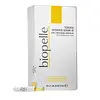What's inside
What's inside
 Key Ingredients
Key Ingredients

 Benefits
Benefits

 Concerns
Concerns

 Ingredients Side-by-side
Ingredients Side-by-side

Water
Skin ConditioningNiacinamide
SmoothingFucus Vesiculosus Extract
EmollientFumaria Officinalis Extract
Skin ConditioningNasturtium Officinale Extract
PerfumingPanax Ginseng Root Extract
EmollientRosmarinus Officinalis Leaf Extract
AntimicrobialScrophularia Nodosa Extract
Skin ConditioningUrtica Dioica Leaf Extract
Skin ConditioningAgrimonia Eupatoria Extract
AstringentPanthenol
Skin ConditioningPentylene Glycol
Skin ConditioningSodium Hyaluronate
HumectantHydrolyzed Lupine Protein
Skin ConditioningSphingolipids
EmollientSorbitol
HumectantP-Anisic Acid
MaskingTocopherol
AntioxidantXanthan Gum
EmulsifyingPhospholipids
Skin ConditioningAlcohol Denat.
AntimicrobialEthylhexylglycerin
Skin ConditioningCitric Acid
BufferingPantolactone
HumectantSodium Citrate
BufferingPhenoxyethanol
PreservativeSodium Benzoate
MaskingWater, Niacinamide, Fucus Vesiculosus Extract, Fumaria Officinalis Extract, Nasturtium Officinale Extract, Panax Ginseng Root Extract, Rosmarinus Officinalis Leaf Extract, Scrophularia Nodosa Extract, Urtica Dioica Leaf Extract, Agrimonia Eupatoria Extract, Panthenol, Pentylene Glycol, Sodium Hyaluronate, Hydrolyzed Lupine Protein, Sphingolipids, Sorbitol, P-Anisic Acid, Tocopherol, Xanthan Gum, Phospholipids, Alcohol Denat., Ethylhexylglycerin, Citric Acid, Pantolactone, Sodium Citrate, Phenoxyethanol, Sodium Benzoate
Propylene Glycol
HumectantSnail Secretion Filtrate
Skin ConditioningWater
Skin ConditioningMaltodextrin
AbsorbentSaccharide Isomerate
HumectantHexylene Glycol
EmulsifyingPolysorbate 20
EmulsifyingPEG/PPG-20/6 Dimethicone
EmulsifyingSodium Ascorbyl Phosphate
AntioxidantSodium Chloride
MaskingFructose
HumectantGlucose
HumectantTocopheryl Acetate
AntioxidantPolyquaternium-10
Citric Acid
BufferingTetrasodium EDTA
Phenoxyethanol
PreservativeParfum
MaskingUrea
BufferingDextrin
AbsorbentSucrose
HumectantGeraniol
PerfumingAspartic Acid
MaskingGlutamic Acid
HumectantAlanine
MaskingHexyl Nicotinate
EmollientSodium Citrate
BufferingHydroxycitronellal
PerfumingLinalool
PerfumingCoumarin
PerfumingHexyl Cinnamal
PerfumingLimonene
PerfumingPropylene Glycol, Snail Secretion Filtrate, Water, Maltodextrin, Saccharide Isomerate, Hexylene Glycol, Polysorbate 20, PEG/PPG-20/6 Dimethicone, Sodium Ascorbyl Phosphate, Sodium Chloride, Fructose, Glucose, Tocopheryl Acetate, Polyquaternium-10, Citric Acid, Tetrasodium EDTA, Phenoxyethanol, Parfum, Urea, Dextrin, Sucrose, Geraniol, Aspartic Acid, Glutamic Acid, Alanine, Hexyl Nicotinate, Sodium Citrate, Hydroxycitronellal, Linalool, Coumarin, Hexyl Cinnamal, Limonene
Ingredients Explained
These ingredients are found in both products.
Ingredients higher up in an ingredient list are typically present in a larger amount.
Citric Acid is an alpha hydroxy acid (AHA) naturally found in citrus fruits like oranges, lemons, and limes.
Like other AHAs, citric acid can exfoliate skin by breaking down the bonds that hold dead skin cells together. This helps reveal smoother and brighter skin underneath.
However, this exfoliating effect only happens at high concentrations (20%) which can be hard to find in cosmetic products.
Due to this, citric acid is usually included in small amounts as a pH adjuster. This helps keep products slightly more acidic and compatible with skin's natural pH.
In skincare formulas, citric acid can:
While it can provide some skin benefits, research shows lactic acid and glycolic acid are generally more effective and less irritating exfoliants.
Most citric acid used in skincare today is made by fermenting sugars (usually from molasses). This synthetic version is identical to the natural citrus form but easier to stabilize and use in formulations.
Read more about some other popular AHA's here:
Learn more about Citric AcidPhenoxyethanol is a preservative that has germicide, antimicrobial, and aromatic properties. Studies show that phenoxyethanol can prevent microbial growth. By itself, it has a scent that is similar to that of a rose.
It's often used in formulations along with Caprylyl Glycol to preserve the shelf life of products.
Sodium Citrate is the sodium salts of citric acid. In skincare, it is used to alter pH levels and acts as a preservative.
Its main functions are to maintain the pH of a product and neutralize metal ions.
The acidity of our skin is maintained by our glands and skin biome; normal pH level of skin is slightly acidic (~4.75-5.5).
Being slightly acidic allows our skin to create an "acid mantle". This acid mantle is a thin barrier that protects our skin from bacteria and contaminants.
Learn more about Sodium CitrateWater. It's the most common cosmetic ingredient of all. You'll usually see it at the top of ingredient lists, meaning that it makes up the largest part of the product.
So why is it so popular? Water most often acts as a solvent - this means that it helps dissolve other ingredients into the formulation.
You'll also recognize water as that liquid we all need to stay alive. If you see this, drink a glass of water. Stay hydrated!
Learn more about Water